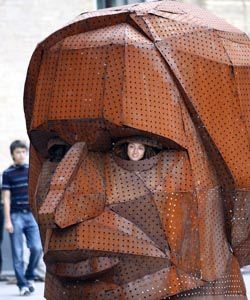Unexpected holiday
GogolFest is set to become the main cultural event in Ukraine
An important role for the Gogolfest’s success was played by the fact that the Mystetskyi Arsenal Art Center, the festival venue, opened new premises this year. Without exaggeration, the building has colossal potential. High ceilings and windows offer a wonderful possibility to organize any kind of exhibit. The acoustics are very good for academic music concerts. The ancient 200-year-old interiors provide the best environment for any performance. The spacious building can accommodate a virtually unlimited number of people and create the most fantastic show.
The organizers have taken advantage of these possibilities by properly arranging various stages, the video hall, and the club-cum-caf?. Painters were given the largest space. Every more or less active gallery of Kyiv is presented here, but there is no sense in listing them: there are photos, paintings, and video projections are on the walls and dozens of installations are set up in the middle of the halls. Thus, contemporary art appears to serve as decorations for the Gogolfest.
Like last year, the festival was launched by the performance of the AXE Engineering Theater from Saint Petersburg. This time art-engineers Pavel Semchenko and Maksim Isaev did not stage one of their plays but rather created the show on the spot, involving Kyiv artists, specifically the folk music band DakhaBrakha.
They started in the yard, painting the heads of the extras red. Thereafter the action moved into the building of the Mystetsky Arsenal and continued on a pole-supported stage with a table and three-storied scaffolding. In each part of the scaffolding performers were engaged in monotonous activity—reading aloud, painting, dishwashing, writing, singeing pig heads. The play was called A Birthday Party, so most activity took place, fittingly, at the table.
The AXE employed its usual elements—dry substances, water, paints, and fire. The plot was also traditionally based on the clash between the masculine and the feminine. The Host was played by a red-white guy. Maksim and Pavel, who resembled eccentric ancient scientists in their long coats, introduced him into the action with the help of various ritual manipulations. Then girls with red-painted heads started to come using a rope bridge to see the Host. Each of them set about her own business: one threw plates on the floor, another one triumphantly tore pages out of a huge folio, while the third one sang.
The Host and the AXE chiefs were making strange gestures; everyone was moving around the table, on the table and even under it. The movement was accompanied by the rhythmic beat of electronic percussion, resembling either an insane tank or guided chaos. Tamtams thundered, fire burned, water flew, and jagged fragments of broken plates and bottles flew in all directions. The avant-garde extravaganza ended triumphantly: the Host, who had been nailed to the table, straightened up and sat on the overthrown table, dozens of bottles were uncorked, and streams of champagne poured onto the audience.
The launch was a success, and to some extent it set the tone for the entire GogolFest. Different programs unite spectacular efficiency of the performance, on the one hand, and an elitist, sometimes hermetic art, on the other. For example, the whole music block was well arranged: from rock to academic music concerts. The French ensemble Accroche Note performed ironic, formally perfect music by Georges Aperghis, who is still unknown in Ukraine.
Without doubt, the concert of the new music band Klaster conducted by Ivan Nebesny was an event of immense importance. This formation, which is one of the most interesting present-time academic performers, has not appeared on stage for many years, so the fact that the ensemble performed in its classic composition, including the brilliant vocalist Svitlana Hleba, was even more precious. An immense impression was produced by the festival’s only concert of symphonic music (National Academic Symphony Orchestra of Ukraine conducted by Volodymyr Sirenko). It played the compositions by Viktoria Poliova and Sviatoslav Luniov, which were, truly, tragic art par excellence.
The performance of the Polish group Karbido was a part of the theatrical program, but in reality this was a concert, albeit an unusual one: all four musicians were sitting at the table, using it as an instrument. The table was a whole set of instruments and took two months to equip. The Karbido crew are indisputably talented actors, but even more captivating was what they performed on their “table.” Only real masters can produce such virtuoso performance, such richness of sound and rhythm, and such polyphony of styles—from funk to free jazz. Doubtlessly, the Polish quartet appeared to be a real star since at the very beginning of GogolFest. (incidentally, they are not newcomers to Ukraine, as they have released the album Samogon in cooperation with Yurii Andrukhovych.)
The first days of the festival were packed with activity, so much so that it is impossible to put all interesting things in one article. GogolFest has indeed become the living core of the capital’s culture life, and The Day will definitely continue to follow its events. In the end, however, it is worth mentioning that the main thing achieved by the organizers was an unparalleled, truly festive atmosphere. The spirit of joyful play and an absolute carnival is reigning in the Arsenal, where the audiences create their own multifaceted performance. Given also the high-quality program, there is every reason to speak about the third GogolFest as the most remarkable art event—not only this season but also of the last several years.






